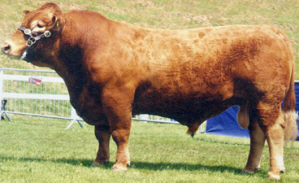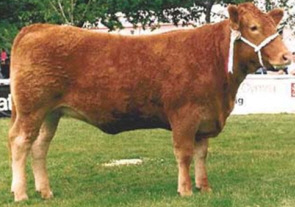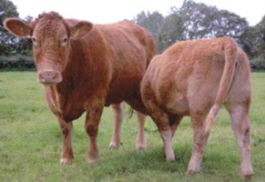



South Devon
History
The South Devon (which is different to the North Devon) originated in South West England around 400 years ago, in an area of Devon known as the South Hams, from here they spread right across the counties of Devon and Cornwall. Photo courtesy of The Trewint Herd, www.trewintfarm.co.uk/southdevons |
This breed has had a varied history, including being exported to North American colonies, some went on the Mayflower in 1620, and during the Napoleonic wars they supplied the needs of the Royal Navy. The main expansion of the South Devon breed across the whole of the country did not happen until the 20th century.
The South Devon was well established as a breed by the year 1800. Around this time they were used as draft animals to pull ploughs and also for their beef and rich milk. During the middle years of that century careful selection of breeding stock improved the breed considerably. The South Devon Herd Book Society was founded in 1891 when it was recognised by the Government as an official body, and the South Devons became one of the 14 breeds of cattle whose Herd Books date back to the second half of the 19th century.
At the beginning of the 20th century the South Devon was considered as triple purpose – for the production of beef, milk and butterfat. Many exports helped support the South Devon farmers’ income at this time, with cattle regularly being purchased for the overseas markets at Society sales.
By the 1960's the gradual progression towards a specialist beef breed began when a beef recording scheme started for South Devons, whose successor, BLUP, is applied today by Breedplan. In the early 1970's a beef boom in the UK saw an increase in demand for South Devon cattle in the regions outside Devon and Cornwall, some 5000 head of cattle being taken each year for finishing to other parts of the country. This led to a demand for breeding stock as well. Exports also increased with 170 bulls being exported to Canada alone, followed by 90 to South Africa and 150 to the USA.
Characteristics
The South Devon has a strong curly coat which is usually a light medium red colour but this can vary in shade and sometimes can appear mottled, they also are pink around the eyes, nose and muzzle. Photo courtesy of The Grove Herd, www.southdevons.co.uk |
The bulls can begin to be used around 15-18 months of age and carry on working upto 12 years. In the non-pedigree herd the South Devon bull can be used as a crossing sire or as a terminal sire.
The South Devon female is early maturing and may be calved at 2 years of age, although calving at 2½ to 3 is still quite common. The average gestation length is 286 days, cows calve every year for as long as 15 years. Most births are single calves but twins do occur in approximately 10% of calvings.
The breed are known for their docile nature, the bulls have gained the name "the Gentle Giant".
Statistics
Comparative
 Photo courtesy of The Grove Herd, www.southdevons.co.uk |
www.southdevons.co.uk
Distribution
The South Devon has proved exceptionally adaptable to varying climatic conditions and is presently well established on five continents. The breed is well represented in Britain, the USA, South Africa, Australia and New Zealand.References (the above information was cited from the following sites)
www.sdhbs.org.uk
www.southdevons.co.uk
www.trewintfarm.co.uk/southdevons


